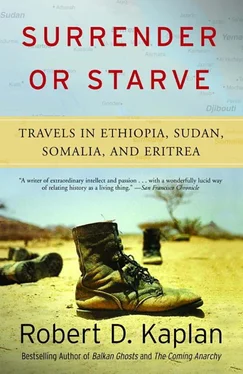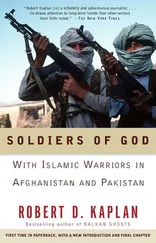The old rulers kept the peasants poor, chained to the soil by debt so that no heads were ever raised in defiance. But at least the feudal lords knew something of the land, how much it would produce….
But the new men, they were from the city and knew nothing of the soil. They had dead eyes and spoke in riddles. They took everything the peasant produced and for a price so low it brought death and withering of the crops, fear, and whispers. And the new man heard everything and forgot nothing, even what a man murmured in his sleep. Many a peasant went to jail wondering what it was he had said and against whom.
Carter’s strategy emphasized human rights and diplomacy. The Kremlin interpreted this as just plain weakness. The USSR moved more than $1 billion in arms to take over a country while the United States did nothing except stand on ceremony. In coming years, hundreds of thousands would die as a result. Ethiopia obviously took up a significant amount of Carter’s time at the beginning of his term in office. But it’s difficult to find a reference about Ethiopia in his memoir Keeping Faith.
By the time Ronald Reagan took office, Ethiopia was well on its way to becoming Moscow’s first African satellite. Although the maturation of the Eritrean and Tigrean guerrilla resistances offered Reagan the chance to destabilize the Dergue through the use of proxy armies, the conservative Republican president, while willing to arm less competent guerrilla groups in other parts of the globe, did next to nothing in Ethiopia. In 1981, Reagan authorized the Central Intelligence Agency to provide $500,000 yearly to the London-based EPDA in order to distribute antigovernment leaflets and audiovisual material inside Ethiopia. The EPDA was multiethnic and democratic, but it also had few guerrillas in the field. Countering Soviet guns and East German surveillance techniques with leaflets and soundtracks was the kind of gentlemanly course of action that Carter would have employed had he been reelected in 1980.
In 1984, the famine emergency gave the United States what it thought was an opportunity to weaken Moscow’s hold over Ethiopia using peaceful means. While the Soviet Union provided less than 1 percent (10,000 tons out of 1.25 million) of the emergency food aid, the noncommunist world provided 99 percent. Mengistu was not impressed, however. During a November 1985 visit to Moscow, the Ethiopian leader, according to the TASS news agency, “expressed profound gratitude to the USSR for its… assistance in strengthening the economy and defensive capacity of socialist Ethiopia and in overcoming the consequences of the severest drought.” No similar tribute was paid to the West.
In June 1986, Ethiopia released a draft of its new constitution. Aleme Eshete, an Ethiopian scholar, described it as “almost an abridged translation of the Soviet constitution of 1977. One does not see Ethiopia in it. The chapters of the Soviet constitution are all reproduced in order.” The only major exception was the part dealing with the office and powers of the president, which was lifted almost straight out of the Romanian constitution, in order to give Mengistu the kind of absolute power enjoyed by President Nicolae Ceausescu.
The U.S. position in Ethiopia in the mid 1980s was worse than ever. Said a diplomat at the U.S. Embassy in Addis Ababa: “We could wake up tomorrow morning and find that we’re being kicked out.” Indeed, the record in Sudan and Ethiopia had made one thing clear: in the struggle against totalitarianism, bread alone was never enough.
At the southern entrance to the Red Sea, across the shark-infested waters from Ethiopia and Somalia, lie North and South Yemen. The two Yemens offer a mirror image of the reality in the Horn of Africa and therefore provide another clue as to why the U.S. position in Ethiopia is worse than it ever has been, despite the generous outpouring of famine aid.
Although one often is confused with the other, the historical experience of the two Yemens has been markedly different. In 1839, the British occupied Aden, at the southwest tip of the Arabian peninsula, where they established a coal-bunkering port for ships sailing to and from India. A debilitating form of colonialism ensued. While Aden boomed, nothing was done to develop or, more importantly, to integrate the adjacent hinterland. Order was kept by bribing the local tribal chiefs. Not surprisingly, the radical guerrilla movement that ousted the British in 1967 was dominated by up-country tribespeople, who would use extreme methods to unify what had been no more than an assemblage of separate little protectorate states rimming Aden. The preconditions for the Marxist straitjacket in the country that came to be known as South Yemen thus were formed.
But neither the British nor anyone else could ever colonize the tribespeople in the high mountains and deserts in the far north— the legendary home of the Queen of Sheba. The Ottoman Turkish hold over this region was nothing more than a four-hundred-year-long series of bloody failures. Only in 1962 was the sultanate—as medieval as the court of Haile Selassie—abolished. Even so, North Yemen remains a stronghold of xenophobic traditionalism much like Ethiopia and Afghanistan, and like both of those countries, the first group of foreign invaders able to successfully penetrate North Yemen may turn out to be the Soviets.
The similarities between North Yemen and Ethiopia are, to say the least, unsettling. In antiquity, both places shared a story-book aura as civilizations existing in mountainous isolation at the very edge of the known world renowned for their gold, spices, frankincense, and precious stones. According to tradition, the line of Ethiopian kings that ended with Haile Selassie was started by the Yemenite Queen of Sheba and the Hebrew King Solomon. Axum, the first great Ethiopian kingdom, was established by colonists from Yemen, which was known to the Romans as Arabia Felix (Fortuante Arabia) on account of its wealth. In the intervening centuries, only the most intrepid explorers were able to scale the fortress of mountains that kept both Yemen and Ethiopia locked away in a cultural time warp. Exactly like Ethiopia, North Yemen was one of the few places in the Third World that totally withstood the bastardizing influence of the West until the second half of the twentieth century and even now is an anthropologist’s dream come true. The Zaidi version of Shiite Islam practiced in Yemen was no less strange and unique than was the form of Coptic Christian orthodoxy practiced in Ethiopia. Visiting the area in the 1950s, the late British journalist David Holden wrote in Farewell to Arabia, “Secluded behind its mountain barriers, protected by its sheer lack of physical communications and the fitful hostility of its Imams, the Yemen maintained a reputation of unusual mystery, even for Arabia… a medieval survival, a kingdom of silence.”
The same could be said for Ethiopia.
I was the only U.S. journalist in North Yemen following the bloody coup and tribal war in South Yemen in early 1986, and I was allowed in by mistake—the North Yemeni consul in Greece who gave me the visa was unaware that the Ministry of Information had banned news reporters from the country. It was very much as Holden described it: a land of iron-red canyons, basalt plateaus, and beehive-like villages tripping down mountainsides whose terraced green fields exuded an almost tropical remoteness. The men wore turbans, plaid skirts, and curved daggers thrust inside their belts and retired every afternoon to chew qat, a narcotic leaf whose affect is similar to marijuana. But there was nothing exotic about the politics. As in the Horn, the great nineteenth-century game of grand strategy was in progress.
The Soviets moved into South Yemen at the same time that they were moving into Somalia. A listening post, naval anchorage, and runway suitable for long-range reconnaissance flights were constructed at Aden; while on the South Yemeni island of Socotra off the Somali coast—at the very tip of the African Horn—submarine facilities were installed.
Читать дальше












